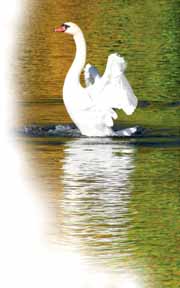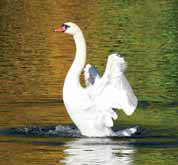|

Graceful water birds
Swans - graceful and beautiful to look at, have been the inspiration of
many a poetic expression, song, art and sculpture. Even theatrical
productions have been woven around these feathered beauties. The famous
Russian ballet 'Swan Lake' speaks volumes for the manner in which swans
have inspired great artists over the years.

Swans are considered a symbol of purity and fidelity, and ornaments in
their image are often used to adorn cakes at engagements and weddings. It
has been documented by researchers that swans choose their partners for
life ....
There are many types of swans such as the Whooper swan, Trumpeter swan,
Tundra swan, Black swan and Mute swan.
Whooper swans are distributed in Northern Europe and Asia, from Iceland
East to Bering Sea. Spectacular in flight, these big white birds with a
wingspan of up to 240 cm (nearly 8 ft) are wild, and not easy to approach
like the Mute swans. The average length of an adult bird is 145-160 cm
(57-63 in) of which the neck accounts for about half.
The loud and far carrying call of the Whooper swans when in unison,
gives one the impression of singing. It's like a triple blast on a bugle.
For this reason, this beautiful water bird is called the 'Singing swan' in
several languages.
These birds breed only in the wild regions of tundra and swampland, and
migrate to warmer regions during winter. They fly at heights of 27,000 ft
which is just beneath the jet-stream, where winds are strong and often
blow at over 180km/h or 112 mph. With an air density and oxygen
concentration of only 40 per cent, man cannot survive in such conditions
and it's amazing that some birds can fly at such heights. It proves that
their respiratory system is superior to man's.
 Whooper swans survive on aquatic vegetation and animals and
occasionally berries. Black swans are vegetarians and are found mostly
throughout Australia, including Tasmania, with the exception of Cape York
Peninsula. They are also found in New Zealand and Sweden, having been
introduced to these countries. These birds prefer large salt, brackish or
fresh waterways and permanent wetlands as habitats. With a body length of
142cm, these birds need 40m or more clear water to take off. Whooper swans survive on aquatic vegetation and animals and
occasionally berries. Black swans are vegetarians and are found mostly
throughout Australia, including Tasmania, with the exception of Cape York
Peninsula. They are also found in New Zealand and Sweden, having been
introduced to these countries. These birds prefer large salt, brackish or
fresh waterways and permanent wetlands as habitats. With a body length of
142cm, these birds need 40m or more clear water to take off.
The body feathers are mostly black, with the exception of broad white
wing tips which are visible only in flight. The bill or beak is a deep
orange-red, paler at the tip and has a distinct narrow white band towards
the end. The young birds are grey coloured and have black wing tips.
The little swans do not grow very fast and mature only when they are
three years old. Parents defend their nest and young ferociously. Nests
are built near the water's edge, usually in large mounds of grasses and
reeds. The female lays 5-8 large greenish eggs that are incubated by both
parents for about 36 days. The chicks are able to swim and feed themselves
as soon as they are hatched.
The black swans are the most social of all swans.
The Trumpeter swans or the White swans are the largest of the North
American water fowl. They are full white with a long, straight neck and a
black bill. Measuring around 138-158cm (54-62 in) these birds have a
wingspan of 203 cm or 80 inches. The wings make a raspy noise in flight.
They have a hollow, nasal honking call. In the early 20th century these
birds were reduced to near extinction due to excessive hunting for their
feathers. Wild trumpeter swans, believed to mate for life, are known to
form pair bonds when they are 3-4 years old. They are known to live for
more than 24 years.
 Tundra swans, true to their name, breed on the high tundra across the
upper regions of North America. Large, all white, with a long, straight
neck, black bill, these birds have a goose-like honking, call. They stay
in flocks except when on breeding territory. Tundra swans, true to their name, breed on the high tundra across the
upper regions of North America. Large, all white, with a long, straight
neck, black bill, these birds have a goose-like honking, call. They stay
in flocks except when on breeding territory.
During the breeding season, they sleep almost entirely on land, but in
winter, they sleep more often on water.The Whisting swan, the American
race of the tundra swan is currently considered the same species as the
Eurasian race, the Bewick's swan. They were considered separate species
due to the large yellow patches on the face of the latter species - (Bewick's
swans)
Mute swans are not mute in reality as their name indicates, because
they do make quiet calls which do not carry. A snorting sound and hissing
could be heard. Large, all white with a long, curved neck, these swans
have orange bills and black faces. Both male and female birds look alike
but the male is slightly larger with a larger knob on the bill.The Mute
swan too is reported to mate for life.
 They re-mate if their partner dies. If a male loses its mate, and pairs
with a young female, she comes over to his territory. But if he mates with
an older female, he goes to hers. If a female loses her mate, she re-mates
quickly and usually goes for a younger mate.Downy young Mute swans called
cygnets come in two colours - a grey form and a white form. They re-mate if their partner dies. If a male loses its mate, and pairs
with a young female, she comes over to his territory. But if he mates with
an older female, he goes to hers. If a female loses her mate, she re-mates
quickly and usually goes for a younger mate.Downy young Mute swans called
cygnets come in two colours - a grey form and a white form. |

